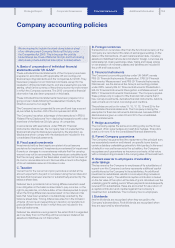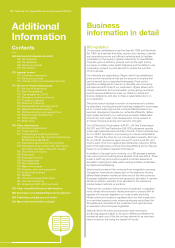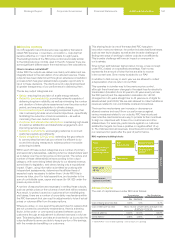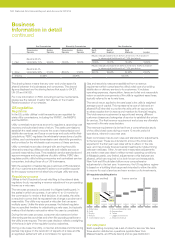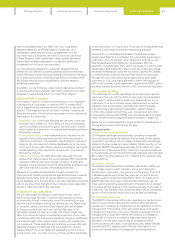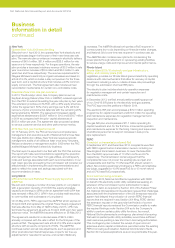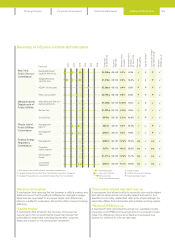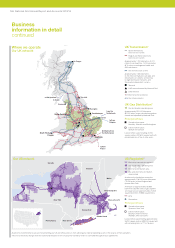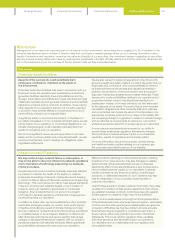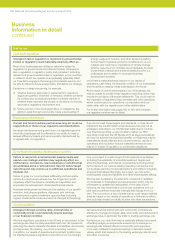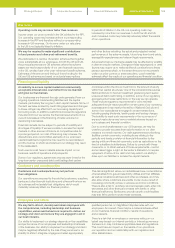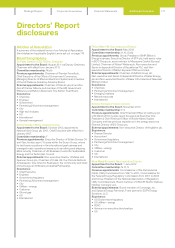National Grid 2014 Annual Report Download - page 165
Download and view the complete annual report
Please find page 165 of the 2014 National Grid annual report below. You can navigate through the pages in the report by either clicking on the pages listed below, or by using the keyword search tool below to find specific information within the annual report.
Strategic Report Corporate Governance Financial Statements Additional Information
networks (upstate New York, New York City, Long Island,
Massachusetts (2), and Rhode Island). Distribution and
transmission electricity services in upstate New York are
recovered with a combined rate billed to end use customers.
InNew England, retail transmission rates recover wholesale
transmission charges assessed to our electric distribution
companies from our end use customers.
Our rate plans are designed to a specific allowed RoE, by
reference to an allowed operating expense level and rate base.
Some rate plans include earnings sharing mechanisms that allow
us to retain a proportion of the earnings above our allowed RoE
weachieve through improving efficiency, with the balance
benefiting customers.
In addition, our performance under certain rate plans is subject
toservice performance targets. We may be subject to monetary
penalties in cases where we do not meet those targets.
Allowed RoE in context
One measure used to monitor the performance of our regulated
businesses is a comparison of achieved RoE to allowed RoE,
witha target that the achieved should be equal to or above the
allowed. This measure cannot be used in isolation, however, as
there are anumber of factors that may prevent us from achieving
that target in any given year:
• Regulatory lag: in the years following the rate year, costs may
increase due to inflation or other factors. If the cost increases
cannot be offset by productivity gains, the total cost to deliver
will be higher as a proportion of revenue and therefore achieved
RoE will be lowered.
• Cost disallowances: a cost disallowance is a decision by the
regulator that a certain expense should not be recovered in
rates from customers. The regulator may do this for a variety of
reasons. We can respond to some disallowances by choosing
not to incur those costs; others may be unavoidable. As a result,
unless offsetting cost reductions can be found, the achieved
RoE will be lowered.
• Market conditions: if a utility files a new rate case, the new
allowed RoE may be below the current allowed RoE as financial
market conditions may have changed. As such, a utility that
appears to be underperforming the allowed RoE and files a new
rate case may not succeed in increasing revenues.
We work to increase achieved RoEs through: productivity
improvements; positive performance against incentives or earned
savings mechanisms such as energy efficiency programmes,
where available; and, through filing a new rate case when achieved
returns are lower than that which the Company could reasonably
expect to attain through a new rate case.
Features of our rate plans
We are responsible for billing our customers for their use of
electricity and gas services. Customer bills typically comprise
acommodity charge, covering the cost of the electricity or gas
delivered, and charges covering our delivery service. Depending
on the state, delivery rates are either based upon actual sales
volumes and costs incurred in an historical test year, or on
estimates of sales volumes and costs, and in both cases may
differ from actual amounts. A substantial proportion of our costs,
in particular electricity and gas purchases for supply to customers,
are pass-through costs, meaning they are fully recoverable from
our customers. These pass-through costs are recovered through
separate charges to customers that are designed to recover
thosecosts with no profit. Rates are adjusted from time to time
toensure any over- or under-recovery of these costs is returned to,
or recovered from, our customers. There can be timing differences
between costs being incurred and rates being adjusted.
Revenue for our wholesale transmission businesses in New
England and New York is collected from wholesale transmission
customers, who are typically other utilities and include our own
New England electricity distribution businesses. With the
exception of upstate New York, which continues to combine retail
transmission and distribution rates to end use customers, these
wholesale transmission costs are incurred by distribution utilities
on behalf of their customers and are fully recovered as a pass-
through from end use customers as approved by each state
commission. Our Long Island generation plants sell capacity to
LIPA under a power supply agreement, approved by FERC, which
provides a similar economic effect to cost of service rate regulation.
US regulatory filings
The objectives of our rate case filings are to ensure we have the
right cost of service with the ability to earn a fair and reasonable
rate of return, while providing a safe and reliable service to our
customers. In order to achieve these objectives and to reduce
regulatory lag, we have been requesting structural changes,
suchas revenue decoupling mechanisms, capital trackers,
commodity-related bad debt true-ups, and pension and other
post-employment benefit (OPEB) true-ups, separately from base
rates. These terms are explained below the table on page 165.
Below we summarise significant developments in rate filings and
the regulatory environment during the year.
Massachusetts
Capital investment programmes
Our Massachusetts gas and electricity operating companies
haverate mechanisms that allow for the recovery of new capital
investment, including a return, outside of base rate proceedings,
subject to further review and reconciliation. Most recently, on the
gas side, MADPU allowed approximately $11.6 million into rates
effective from 1 November 2013, related to incremental additions
to the rate base, and on the electricity side it allowed approximately
$8.8 million into rates effective from 1 March 2014, related to rate
base additions.
Storm fund recovery
The Massachusetts electricity business collects $4.3 million per
year in base rates to credit towards a storm fund devoted to
funding storm restoration. The severity and frequency of storms
inMassachusetts over the last few years left our storm fund in
adeficit position of approximately $212 million. On 3 May 2013,
MADPU allowed us to begin collecting $40 million per year for
three years towards the replenishment of the storm fund, subject
to a review of the prudency of the underlying costs. That review is
under way. The funding of the remaining deficit will be addressed
as part of the prudency review and in future rate proceedings.
Storm management audit
The MADPU’s December 2012 order regarding our performance
during Tropical Storm Irene and the October 2011 snowstorm
requires us to undergo an independent audit regarding our storm
management. This audit is under way, addressing: emergency
management systems, protocols and plans; preparation for and
management of restoration efforts with respect to emergency
events; the Company’s emergency response resources and
allocation of those resources during an emergency event;
communications with state, municipal and public safety officials
and with the DPU; dissemination of timely information to the
public; and identification of management recommendations.
163




